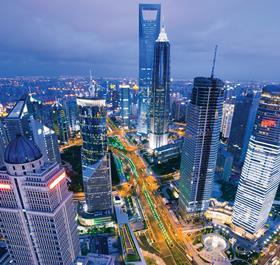PWC report says Asia-Pacific countries will be spending six times as much on infrastructure as their western European counterparts by 2025

Countries in the Asia-Pacific will be spending six times as much on infrastructure as their western European counterparts by 2025, PWC has predicted.
The consultancy’s outlook report for capital project and infrastructure (CP&I) spending, published this week, forecasts that worldwide infrastructure spending is expected to grow to $9tr (£5.3tr) by 2025, compared to the current level of $4tr (£2.4tr).
UK spending on capital projects will rise to £106bn by the mid 2020s, up from £70bn now, according to the report.
Asia-Pacific countries will account for 60% of the 2025 global figure, six times the 10% share of that PwC says western European counterparts will be spending.
Before the financial crisis, western Europe comprised one-fifth of infrastructure spending worldwide.
Richard Abadie, global leader of PWC’s CP&I practice, said: “Emerging markets, especially China and other countries in Asia, without the burden of recovering from a financial crisis, will see much faster growth in infrastructure spending than in advanced economies in Europe.
“Growth in emerging markets, together with increasing urbanization and shifts in demographics, will drive the majority of investment globally.”
The study estimates the global CP&I market should grow by up to 7% annually between 2014- 2025, with UK infrastructure spending growing up 3-4% pa over the same period.
UK infrastructure investment could grow by up 4.5% annually from 2020 onwards, when the fiscal squeeze is due to ease, making up for slower growth during the austerity years (2.4% 2014-19).
PwC predicts that power and transport will account for almost half of spending by 2025, versus around a third today.
Expenditure on power and water is predicted to more than double from the current level of £11bn to £27bn by 2025, including a near tripling in power generation infrastructure spending from £6bn per annum in 2014 to over £17bn in 2025.
Transport spending is expected to increase from £12bn to £23bn, while expenditure on hospitals and schools will increase at a slower rate from £22bn to £28bn per annum.
Abadie said: “It is telling that social infrastructure spending accounts for about a third of total spending currently despite the perception of cutbacks in this area. Nevertheless, we expect transport and power to be the growth sectors up to 2025 with transport almost doubling and power generation nearly tripling. This spending will be critical to ensuring economic growth in the UK and global competitiveness.
“Private investment, whether from pension funds, insurance companies, sovereign wealth funds for example, will be the dominant financing source for this spending as government has signalled previously.”




























No comments yet